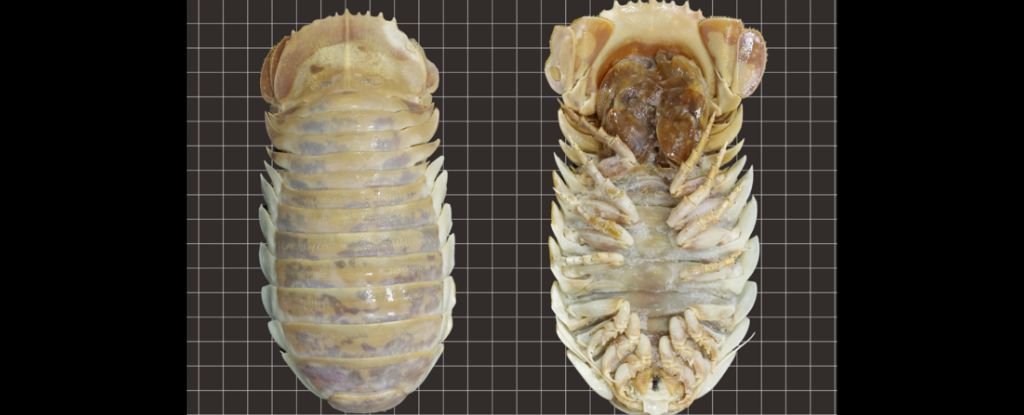
Posted on 08/10/2022 8:10:59 AM PDT by Red Badger

(Dr Ming-Chih Huang, Journal of Natural History)
In the case of future catastrophe, it's often said cockroaches will be the last lifeform left standing on Earth. But there's another, more mysterious bug living in the deep that could give roaches a run for their money.
A group of football-sized isopods have been roaming the seafloor like giant, blown-up roly-poly bugs for 200 or 300 million years, even through the dinosaur extinction event.
One of the largest living species today, Bathynomus giganteus, can be found at depths of more than 2,500 meters (8,200 feet). It was first caught off the Gulf of Mexico in 1879, and as it turns out, it might be two species rolled up in one.
A modern analysis of known giant isopods living in the deep sea has found subtle yet significant differences in their DNA and morphology (their shape and structure).
One specimen found in 2017, for instance, had a slender body compared to other B. giganteus specimens, despite being designated as that species initially.
The curious specimen was found off the Yucatán Peninsula between 600 and 800 meters deep, where B. giganteus has been found before. But there was something off about this one. It was slightly shorter in total length, measuring in at 26 centimeters (10 inches), and its antennae were relatively long.
While further data is needed to confirm the specimen's exact taxonomic ranking, researchers suspect it represents a new separate species of Bathynomus, and they have named it B. yucatanensis.
The new species has probably gone overlooked until now because the number of spines on its tail match those of B. giganteus. Until now, that was thought to be a key point of distinction between species.
Researchers also say other specimens from the South China Sea were erroneously labelled as B. kensleyi, when, in fact, molecular and morphological analyses showed they are actually B. jamesi.
"It is increasingly evident that species of Bathynomus may be exceedingly similar in overall appearance, and also that there is a long history of misidentification of species in the genus," the authors of the analysis write.
Today, scientists have cataloged about 20 species of living creatures that belong to the Bathynomus genus.
While these aquatic animals might look similar to giant terrestrial woodlouse, they are also distantly related to crabs, shrimp and lobsters.
In comparison to their relatives, however, we know next to nothing about giant isopods. What we do know suggests they are well-equipped to deal with major extinction events. Sometimes, they can go without food for years.
That's probably necessary in the deep, where nutrients are rare and fiercely competed over. When a meal becomes available, it pays to get to the table first.
In 2019, when researchers dropped an alligator carcass into the Gulf of Mexico, it took a mere day for a troop of giant Bathynomus bugs to descend on the meal. Some of them ate so much they began toppling over as though stupefied.
While an alligator might sound out of place in the ocean, it's common for their carcasses to wash into the Gulf of Mexico via rivers or storms.
Whale falls are also a known food source for giant isopods bugs lying hungry in the deep.
What else these creatures do while they wait for the next meal to drop is a mystery.
"B. giganteus is indeed the species closest to B. yucatanensis," the new paper concludes.
"This indicates that the two species likely had a common ancestor. Additionally, there may also be other undiscovered Bathynomus spp. in the tropical western Atlantic."
We might just be noticing giant pill bugs now, but they've been around for much longer than human curiosity.
There's a good chance they even outlast our species. Their track record is certainly better.
The study was published in the Journal of Natural History.
Ummm, food of the future? /sarcasm
“Shadow Technology”
With so many drugged-up rats, repetition is necessary for their burned-out brains.
These remind me of the parasitic bugs that implant in a fish’s mouth, chew up their tongue, and feed on the food entering the fish’s mouth.
Hell, I was just joking, I didn’t know people actually ATE the things!
Looks like a lot of work for that small amount of meat.
I can’t imagine what the market price for one would be.
They should have called it Bathynomus bidenteus because it is so far underwater.
LOL- a ‘primitive spear-fisherman’ will deep dive to capture it
Poor Mikey tried pop rocks and died (there was a rumor back then that he died of po rocks lol)
Probably a fortune in Asian markets. Just tell everyone it stiffens your little feller.
Well, the roly-poly bug is a fellow isopod.
Thanks Red Badger.
Cocktail sauce...
Disclaimer: Opinions posted on Free Republic are those of the individual posters and do not necessarily represent the opinion of Free Republic or its management. All materials posted herein are protected by copyright law and the exemption for fair use of copyrighted works.